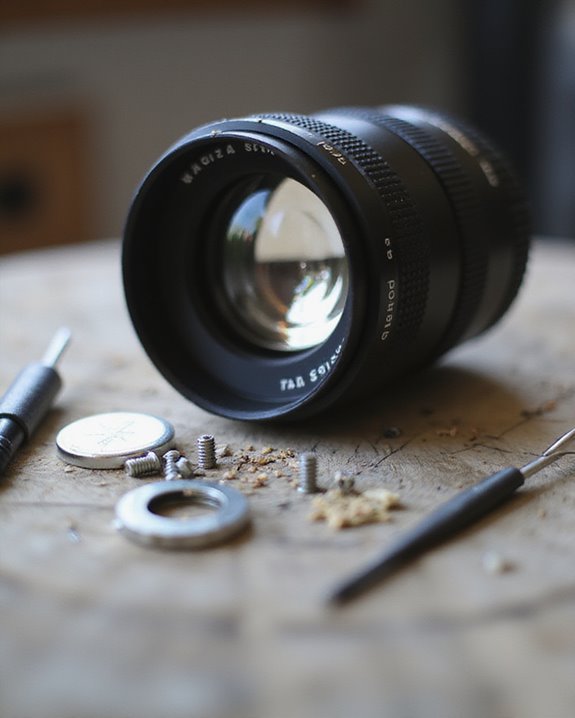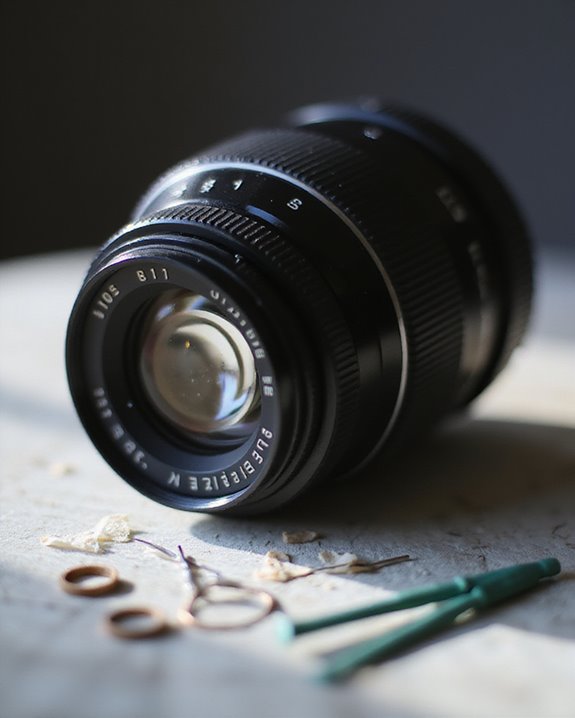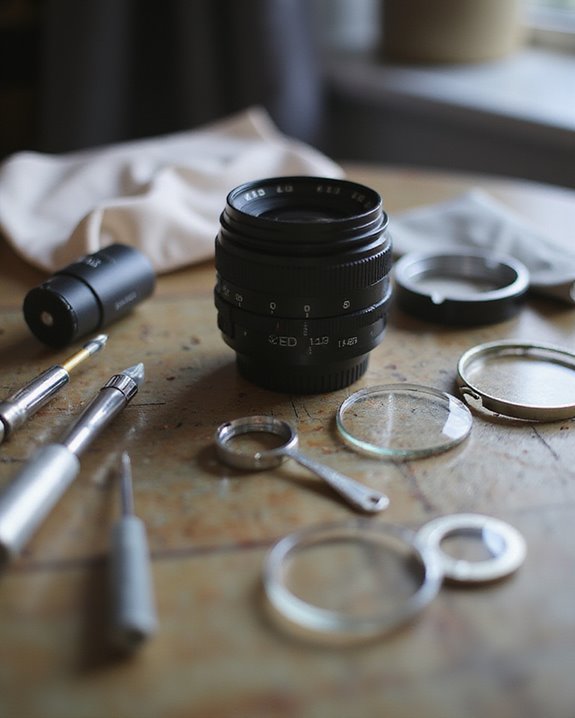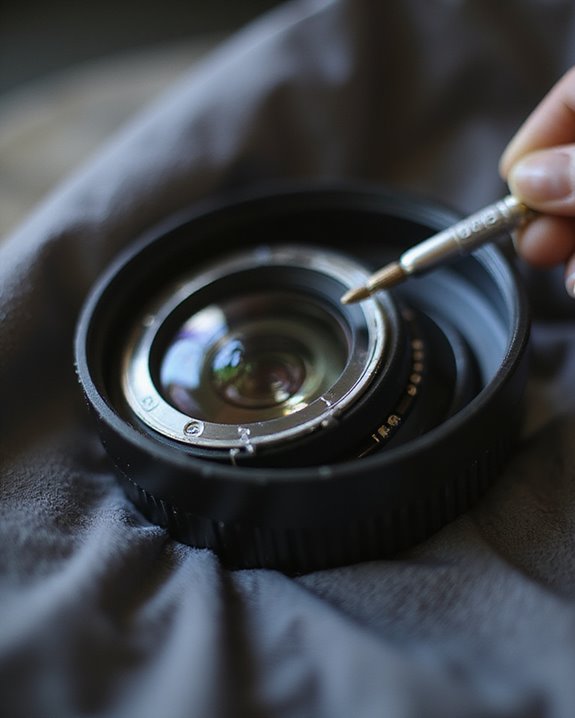Yes, camera lenses can be repaired in many cases. Common issues like external scratches, fungus growth, autofocus malfunctions, and dented filter rings often respond well to proper repair techniques. Simple problems may be addressable through DIY methods with precision tools and anti-static equipment, while complex issues involving optics, electronics, or internal glass damage warrant professional attention. With regular preventive maintenance and appropriate repair approaches, we can extend a lens’s functional lifespan considerably. The following sections explore specific repair scenarios in greater detail.
Key Takeaways
- Most camera lenses can be repaired by professionals, especially for issues like scratches, fungus, or autofocus problems.
- DIY repairs are possible for simple issues like filter ring dents or thread cleaning with proper tools and techniques.
- Complex repairs involving glass elements, electronic components, or optical alignment require professional servicing.
- Essential repair tools include precision screwdrivers, spanner wrenches, anti-static mats, and specialized cleaning materials.
- Repair costs should be weighed against lens value, with high-end optics typically justifying professional repair investments.
Common Camera Lens Problems Worth Repairing
Many camera lens problems can be successfully addressed through professional repair, saving photographers from expensive replacements. External damage, such as lens scratches from accidental drops, can often be buffed or polished by skilled technicians equipped with specialized tools. Similarly, internal issues like fungus growth, which occurs in humid environments and creates web-like patterns that obscure light transmission, can be remediated through careful disassembly and cleaning. Using OEM-quality replacements for internal components helps ensure the longevity and proper functioning of the repaired lens. We’ve found that autofocus mechanisms suffering from misalignment or dust accumulation typically respond well to professional intervention. Stuck filters, element separation, and internal haze are additional issues that often prove repairable rather than terminal. When evaluating repair options, it’s essential to evaluate the lens’s value against repair costs, as high-end optics generally justify professional servicing more than budget alternatives.
DIY Lens Repair Techniques for Beginners

While professional repairs offer peace of mind for valuable equipment, certain camera lens issues can be addressed by photographers themselves with the right tools and techniques. We recommend beginning with proper Workspace Setup, ensuring a clean, dust-free environment with adequate lighting and magnification for detailed work. Safety Measures must include wearing anti-static gloves to prevent oil transfer and coating damage. Using genuine OEM replacement lenses and adhesives can significantly improve repair success and durability OEM kits, making DIY repairs more reliable. For beginners, we suggest starting with simple repairs: reshaping dented filter rings using wooden dies, cleaning damaged threads with matched thread files, or removing dust with professional cleaning solutions. Custom tools can be fashioned from everyday items—lens spanners from scrap materials and calibrated rubber tubes for gripping lens components without scratching. Always document each step with photographs during disassembly, and apply gentle pressure when working with delicate parts to avoid damaging precious optical elements.
When to Seek Professional Lens Repair Services

Despite the allure of DIY repairs, there are specific circumstances when we’d strongly advise photographers to seek professional lens repair services instead of attempting fixes themselves. Complex issues like electronic failures, glass damage, and focal length maladjustments typically require specialized tools and expertise that most enthusiasts don’t possess. Before attempting any repair, we recommend conducting Warranty Verification to guarantee you don’t inadvertently void manufacturer coverage. Similarly, documenting damage thoroughly is essential for Insurance Claims processing, which professional services can often assist with through detailed assessment reports. Additionally, precision optical alignment is crucial for maintaining image quality and should be handled by trained technicians to avoid further damage. Professional repairs, while seemingly costly upfront, ultimately prove more cost-effective by extending your equipment’s lifespan and preserving ideal performance. When dealing with intricate optical alignment, calibration issues, or structural damage to lens mounts, the precision offered by authorized service providers becomes invaluable compared to risky amateur interventions.
Essential Tools for Camera Lens Repair

Successful camera lens repair requires a thorough toolkit that extends well beyond basic household implements, as the intricate nature of optical equipment demands specialized instruments for effective troubleshooting and maintenance. When comparing brands, we’ve found that Japanese precision screwdrivers offer superior performance for delicate work, particularly when manipulating the miniature fasteners common in high-end lenses. Effective tool storage solutions, such as anti-static work mats with designated compartments, prevent loss of microscopic components and protect sensitive electronics from ESD damage. Our recommended essentials include lens spanner wrenches, filter removal tools, precision tweezers, microfiber cloths, and inspection loupes (minimum 10X magnification). For complex repairs involving electronic components, a temperature-controlled soldering station and pin vises become indispensable, especially when working with weather-sealed professional-grade equipment.
Preventive Maintenance to Extend Lens Lifespan

Preserving your camera lens’s best performance requires consistent, methodical preventive maintenance that addresses both external and internal components throughout the equipment’s lifecycle. We’ve found that implementing a Routine Cleaning schedule using appropriate tools—soft-bristled brushes, microfiber cloths, and specialized lens solutions—significantly reduces accumulation of debris that could potentially cause permanent damage. When cleaning, always apply solution to the cloth rather than directly to the lens, and wipe in circular motions from center outward.
Proper Storage conditions are equally critical for longevity. We recommend keeping lenses in cool, dry environments, utilizing silica gel packets to control humidity, and storing them in protective cases when not in use. Consistent use of lens caps, body caps, and UV filters provides additional protection against environmental hazards, extending functional lifespan and maintaining optical clarity.
Frequently Asked Questions
How Does Temperature Affect Lens Repair Success Rates?
We’ve found temperature impacts repair success through thermal stability issues. Condensation can damage components, while material expansion affects precision adjustments. We recommend avoiding temperature extremes before and after repairs for best results.
Can Vintage Lenses Be Repaired With Modern Parts?
What’s old is new again! We’ve found vintage lenses can often receive modern upgrades through compatible parts. We typically use custom fabrication when exact replacements aren’t available, ensuring part compatibility without compromising original character.
Do Insurance Policies Typically Cover Lens Repair Costs?
Most policies don’t automatically cover lens repairs. We’ll need to check our policy limits for camera equipment specifically. Filing insurance claims for lenses often requires specialized coverage beyond standard homeowner’s or renter’s policies.
Is It Possible to Repair Lens Autofocus Calibration Issues?
You’d think autofocus issues need factory repair! We’re happy to report that’s not true. Autofocus recalibration is absolutely possible through DIY calibration techniques or professional services that adjust those pesky front/back focus problems.
How Long Does Professional Lens Repair Typically Take?
We typically see repair duration of 2-3 days for minor fixes and 2-3 weeks for standard issues. Factory service wait estimates extend to 4-6 weeks, depending on parts availability and damage severity.





